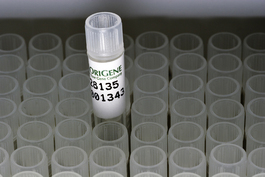KCNJ1 (NM_153766) Human Untagged Clone
CAT#: SC306659
KCNJ1 (untagged)-Human potassium inwardly-rectifying channel, subfamily J, member 1 (KCNJ1), transcript variant rom-k4
"NM_153766" in other vectors (4)
Product Images

Specifications
| Product Data | |
| Type | Human Untagged Clone |
| Tag | Tag Free |
| Symbol | KCNJ1 |
| Synonyms | KIR1.1; ROMK; ROMK1 |
| Vector | pCMV6 series |
| Sequence Data |
>NCBI ORF sequence for NM_153766, the custom clone sequence may differ by one or more nucleotides
ATGTTCAAACATCTTCGGAAATGGGTCGTCACTCGCTTTTTTGGGCATTCTCGGCAAAGA GCAAGGCTAGTCTCCAAAGATGGAAGGTGCAACATAGAATTTGGCAATGTGGAGGCACAG TCAAGGTTTATATTCTTTGTGGACATCTGGACAACGGTACTTGACCTCAAGTGGAGATAC AAAATGACCATTTTCATCACAGCCTTCTTGGGGAGTTGGTTTTTCTTTGGTCTCCTGTGG TATGCAGTAGCGTACATTCACAAAGACCTCCCGGAATTCCATCCTTCTGCCAATCACACT CCCTGTGTGGAGAATATTAATGGCTTGACCTCAGCTTTTCTGTTTTCTCTGGAGACTCAA GTGACCATTGGATATGGATTCAGGTGTGTGACAGAACAGTGTGCCACTGCCATTTTTCTG CTTATCTTTCAGTCTATACTTGGAGTTATAATCAATTCTTTCATGTGTGGGGCCATCTTA GCCAAGATCTCCAGGCCCAAAAAACGTGCCAAGACCATTACGTTCAGCAAGAACGCAGTG ATCAGCAAACGGGGAGGGAAGCTTTGCCTCCTAATCCGAGTGGCTAATCTCAGGAAGAGC CTTCTTATTGGCAGTCACATTTATGGAAAGCTTCTGAAGACCACAGTCACTCCTGAAGGA GAGACCATTATTTTGGACCAGATCAATATCAACTTTGTAGTTGACGCTGGGAATGAAAAT TTATTCTTCATCTCCCCATTGACAATTTACCATGTCATTGATCACAACAGCCCTTTCTTC CACATGGCAGCGGAGACCCTTCTCCAGCAGGACTTTGAATTAGTGGTGTTTTTAGATGGC ACAGTGGAGTCCACCAGTGCTACCTGCCAAGTCCGGACATCCTATGTCCCAGAGGAGGTG CTTTGGGGCTACCGTTTTGCTCCCATAGTATCCAAGACAAAGGAAGGGAAATACCGAGTG GATTTCCATAACTTTAGCAAGACAGTGGAAGTGGAGACCCCTCACTGTGCCATGTGCCTT TATAATGAGAAAGATGTTAGAGCCAGGATGAAGAGAGGCTATGACAACCCCAACTTCATC TTGTCAGAAGTCAATGAAACAGATGACACCAAAATGTAA |
| Restriction Sites | Please inquire |
| ACCN | NM_153766 |
| OTI Disclaimer | Our molecular clone sequence data has been matched to the reference identifier above as a point of reference. Note that the complete sequence of our molecular clones may differ from the sequence published for this corresponding reference, e.g., by representing an alternative RNA splicing form or single nucleotide polymorphism (SNP). |
| OTI Annotation | This TrueClone is provided through our Custom Cloning Process that includes sub-cloning into OriGene's pCMV6 vector and full sequencing to provide a non-variant match to the expected reference without frameshifts, and is delivered as lyophilized plasmid DNA. |
| Product Components | The cDNA clone is shipped in a 2-D bar-coded Matrix tube as dried plasmid DNA. The package also includes 100 pmols of both the corresponding 5' and 3' vector primers in separate vials. Every lot of primer is tested to provide clean sequencing of OriGene TrueClones. |
| Reconstitution | 1. Centrifuge at 5,000xg for 5min. 2. Carefully open the tube and add 100ul of sterile water to dissolve the DNA. 3. Close the tube and incubate for 10 minutes at room temperature. 4. Briefly vortex the tube and then do a quick spin (less than 5000xg) to concentrate the liquid at the bottom. 5. Store the suspended plasmid at -20°C. The DNA is stable for at least one year from date of shipping when stored at -20°C. |
| Reference Data | |
| RefSeq | NM_153766.1, NP_722450.1 |
| RefSeq Size | 2616 bp |
| RefSeq ORF | 1119 bp |
| Locus ID | 3758 |
| Cytogenetics | 11q24.3 |
| Protein Families | Druggable Genome, Ion Channels: Potassium, Transmembrane |
| Gene Summary | 'Potassium channels are present in most mammalian cells, where they participate in a wide range of physiologic responses. The protein encoded by this gene is an integral membrane protein and inward-rectifier type potassium channel. It is activated by internal ATP and probably plays an important role in potassium homeostasis. The encoded protein has a greater tendency to allow potassium to flow into a cell rather than out of a cell. Mutations in this gene have been associated with antenatal Bartter syndrome, which is characterized by salt wasting, hypokalemic alkalosis, hypercalciuria, and low blood pressure. Multiple transcript variants encoding different isoforms have been found for this gene. [provided by RefSeq, Jul 2008]' Transcript Variant: This variant (4, also known as rom-k4) differs in the 5' UTR and coding region compared to variant 1. The resulting isoform (b) is shorter at the N-terminus than isoform a. Variants 2, 4 and 5 all encode isoform b but differ in their 5' UTRs. |
Documents
| Product Manuals |
| FAQs |
Resources
Other Versions
| SKU | Description | Size | Price |
|---|---|---|---|
| RC215003 | KCNJ1 (Myc-DDK-tagged)-Human potassium inwardly-rectifying channel, subfamily J, member 1 (KCNJ1), transcript variant rom-k4 |
USD 420.00 |
|
| RG215003 | KCNJ1 (GFP-tagged) - Human potassium inwardly-rectifying channel, subfamily J, member 1 (KCNJ1), transcript variant rom-k4 |
USD 460.00 |
|
| RC215003L3 | Lenti-ORF clone of KCNJ1 (Myc-DDK-tagged)-Human potassium inwardly-rectifying channel, subfamily J, member 1 (KCNJ1), transcript variant rom-k4 |
USD 620.00 |
|
| RC215003L4 | Lenti-ORF clone of KCNJ1 (mGFP-tagged)-Human potassium inwardly-rectifying channel, subfamily J, member 1 (KCNJ1), transcript variant rom-k4 |
USD 620.00 |
{0} Product Review(s)
Be the first one to submit a review






























































































































































































































































 Germany
Germany
 Japan
Japan
 United Kingdom
United Kingdom
 China
China
